
William Brown was an Irish-born Argentine admiral. Brown's victories in the Independence War, the Cisplatine War and the Anglo-French blockade of the Río de la Plata earned the respect and appreciation of the Argentine people, and he is still regarded as one of Argentina's national heroes. Creator and first admiral of the country's maritime forces, he is commonly known as the "father of the Argentine Navy".

Greater Buenos Aires, also known as the Buenos Aires Metropolitan Area, refers to the urban agglomeration comprising the autonomous city of Buenos Aires and the adjacent 24 partidos (districts) in the Province of Buenos Aires. Thus, it does not constitute a single administrative unit. The conurbation spreads south, west and north of Buenos Aires city. To the east, the River Plate serves as a natural boundary.
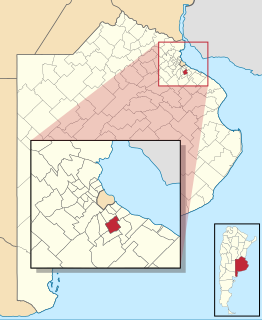
Almirante Brown is a partido of the Buenos Aires Province, Argentina, located at the south of the Gran Buenos Aires urban area, at coordinates 34°47′S58°24′W.

ARA Almirante Irízar is a large icebreaker of the Argentine Navy. She was ordered from a shipyard in Finland in 1975.

Almirante Brown was a Veinticinco de Mayo-class heavy cruiser in service with the Argentine Navy. The ship was named in honour of Admiral Guillermo Brown, the Father of the Argentine Navy.

Emilio Eduardo Massera was an Argentine Naval military officer, and a leading participant in the Argentine coup d'état of 1976. In 1981, he was found to be a member of P2. Many considered Massera to have masterminded the junta's Dirty War against political opponents, which resulted in nearly 13,000 deaths and disappearances, according to official records. Human rights groups put the toll closer to 30,000.
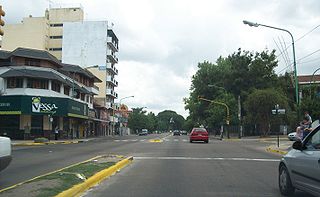
Adrogué is a city in Greater Buenos Aires, Argentina, located 23 km south of Buenos Aires. It is the administrative headquarters for Almirante Brown Partido (county).

Club Almirante Brown is an Argentine sports club headquartered in the San Justo district of La Matanza Partido, in Greater Buenos Aires.
Argentine hemorrhagic fever (AHF) or O'Higgins disease, also known in Argentina as mal de los rastrojos is a hemorrhagic fever and zoonotic infectious disease occurring in Argentina. It is caused by the Junín virus. Its vector is the drylands vesper mouse, a rodent found in Argentina and Paraguay.
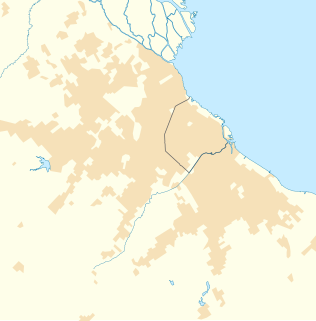
Glew is a city in southern Almirante Brown Partido, Buenos Aires Province, Argentina. Its municipal area of 17.65 km2 (6.81 sq mi) holds a population of 57,878. It is located 34 km (21 mi) from Buenos Aires city, and connected to it by the Ferrocarril General Roca.

Hugo Sigman is an Argentine businessman who is the founder, CEO and –jointly with his wife, Biochemist Silvia Gold— the only shareholder of Grupo Insud, a business group with presence in the fields of pharmaceuticals, agroforestry, cinema, nature and design.

Longchamps is a city in Greater Buenos Aires, Argentina, located about 30 km south of Buenos Aires, in the Almirante Brown Partido (district).
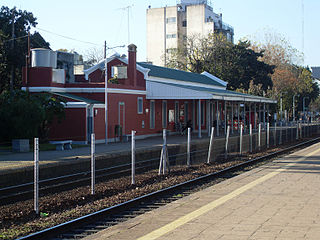
Florida Oeste is a city of the Vicente López Partido in the northern suburbs of Greater Buenos Aires, Argentina. It is principally a middle-class and industrial neighbourhood located between the barrios of Villa Martelli and Munro, also in the same partido (department).

María Teresa Ferrari was an Argentine educator, physician, and women's rights activist. She was the first female university professor in Latin America and one of the first women allowed to teach medicine. She was a pioneering researcher in women's health, studying the use of radiation therapy rather than surgery for uterine tumors and developing a vaginoscope that revolutionized women's health care in Brazil. She established the first maternity ward and gynecological services at the Hospital Militar Central of Buenos Aires in 1925, which provided the first incubation services in the country.
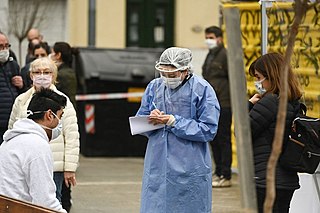
The COVID-19 pandemic in Argentina is part of the worldwide pandemic of coronavirus disease 2019 caused by severe acute respiratory syndrome coronavirus 2. On 3 March 2020, the virus was confirmed to have spread to Argentina. As of 16 December 2020 a total of 1,517,029 people were confirmed to have been infected, and 41,365 people were known to have died because of the virus.
AD5-nCOV, trade-named Convidicea, is a COVID-19 vaccine candidate being developed by Chinese biopharmaceutical company CanSino Biologics. Development of AD5-nCOV began in early 2020 and it entered Phase I testing in March and Phase II testing in April. Beginning in August 2020, it is currently in Phase III trials in Argentina, Chile, Mexico, Pakistan, Russia, and Saudi Arabia with over 40,000 people as both a double-dose and single dose administration.
The following is a timeline of the COVID-19 pandemic in Argentina.
The 2020 COVID-19 pandemic in Argentina had an impact on the human rights situation in the country.














